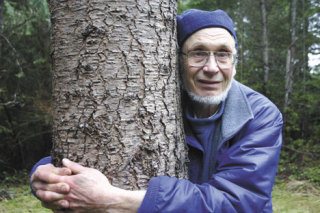Harry Case isn’t one to toot his own horn, at least not like the old days.
But when it comes to his beloved 176 acres of South Whidbey timberland, there’s no holding back his embouchure.
“It’s been a flaming success, and I’ve always wanted to preserve it,” said the retired Seattle Symphony trombonist who lives in Seattle. “Now I’m doing what I’ve always wanted to do.”
Case, 81, who was born in Seattle and grew up in Edmonds, has donated a conservation easement on the South End forest he has owned and nurtured for 63 years.
The easement on the property relinquishes future development rights. Without the easement, the mature conifer forest could be clear cut and subdivided into 35 homesites.
The easement, donated to the Whidbey Camano Land Trust, is the largest forest parcel given to the nonprofit, larger than its nearby 118-acre Saratoga Woods Preserve.
“We are totally thrilled,” said Patricia Powell, land trust executive director. “That forest is incredibly beautiful and diverse, and it will now be around for people and wildlife for generations.”
Incorporated in 1984, the land trust is a local organization working to protect natural habitats, scenic vistas and working farms and forests in partnership with landowners and the community. Its Web site is www.wclt.org.
The trust helped raise the $60,000 needed to complete the easement on the Case property.
“I wouldn’t like to see it butchered,” Case said. “This will be a nice addition to what’s already there.”
Case bought the property near Lone lake Road and close to the 600-acre Putney Woods at a tax-foreclosure sale in 1946. He was 18, and paid $800.
“Nobody else wanted it,” he said. “It’s been a great investment.”
Today, he figures it contains 5 million board feet of timber and is worth more than $1.5 million.
The forest is mostly tall Douglas fir, sprinkled with other conifers and a number of alders.
“I always thought the alder was a weed tree, but it turned out to be the most valuable tree we have,” Case said. “We’re going to encourage alder to come in.”
Case said he was converted to forest conservation as a teenager during a hike near Glacier Peak in the North Cascades, when he came across a particularly vicious logging clear cut.
“I got so disgusted, I told myself I’d get my own property and take care of it,” he said. “I just went in that direction with no looking left or right.”
Through the years, whenever he could get some time off, Case logged selectively and carefully to create a healthy, diverse, mature forest.
Beginning in 1956 and up until a few years ago, he did much of the work himself, cutting trees, pulling them out with a small tractor or with his draft horse, Toby, and planting hundreds of new trees.
He loaded the logs onto his 1941 two-ton Ford pickup and drove it to Waterman Mill in Langley. When the mill closed in the mid-1960s, he took logs to Everett.
Through selective thinning and careful forest practices, Case estimates he has harvested about a million board feet of timber.
“I’ve cried when a tree was blown down in a storm,” he said. “Nature does a sloppy job.”
Case and his wife, Annette, made many trips to the island through the years. They owned a cabin in Langley for awhile, and another
60 acres of forest land.
Case said he paid $300 for that wooded parcel, and later sold it for $36,000, which he used to buy a house in Everett.
“That’s when houses were cheap,” he said.
Case spent 40 years in the trombone section of the Seattle Symphony. He doesn’t play the trombone anymore, because of a loss of lung capacity. But he still plays the baritone horn in a local musical group.
He said he often brought along his trombone during visits to his island forest.
“I’d practice there, and listen to the echo,” he said. “The out-of-doors is good for you. It makes a good sound.”
Case’s grandson, Shawn Connor, began walking in the woods with his grandfather when he was 10. He’s 31 now, and has a degree in forest practices.
He educated Case on the dangers of carbon dioxide, and the important role of trees in sequestering carbon.
“We are digging a grave for civilization with all this carbon dioxide in the air,” Case said. “If we are going to save the environment, little people are going to have to do something. The government isn’t going to do it.”
Connor, who also lives in Seattle, will take over management of the woods someday. He promises to continue on the same careful path as his grandfather.
“I value the intrinsic nature of the ecosystem,” Connor said. “This is the goal we’ve always envisioned, to save open space and increase the standard of living.”
Annette Case still marvels at the woodsy road her husband has taken.
“Where I come from in the Midwest, we called all those things Christmas trees,” she said. “I’ve learned a little bit about them along the way.”
“When I met that guy 40 years ago, he mentioned it as his boyhood dream,” she said of her husband’s desire to protect the forest.
“I’ve just watched his dream come true,” she added. “How happy does that make you?”



